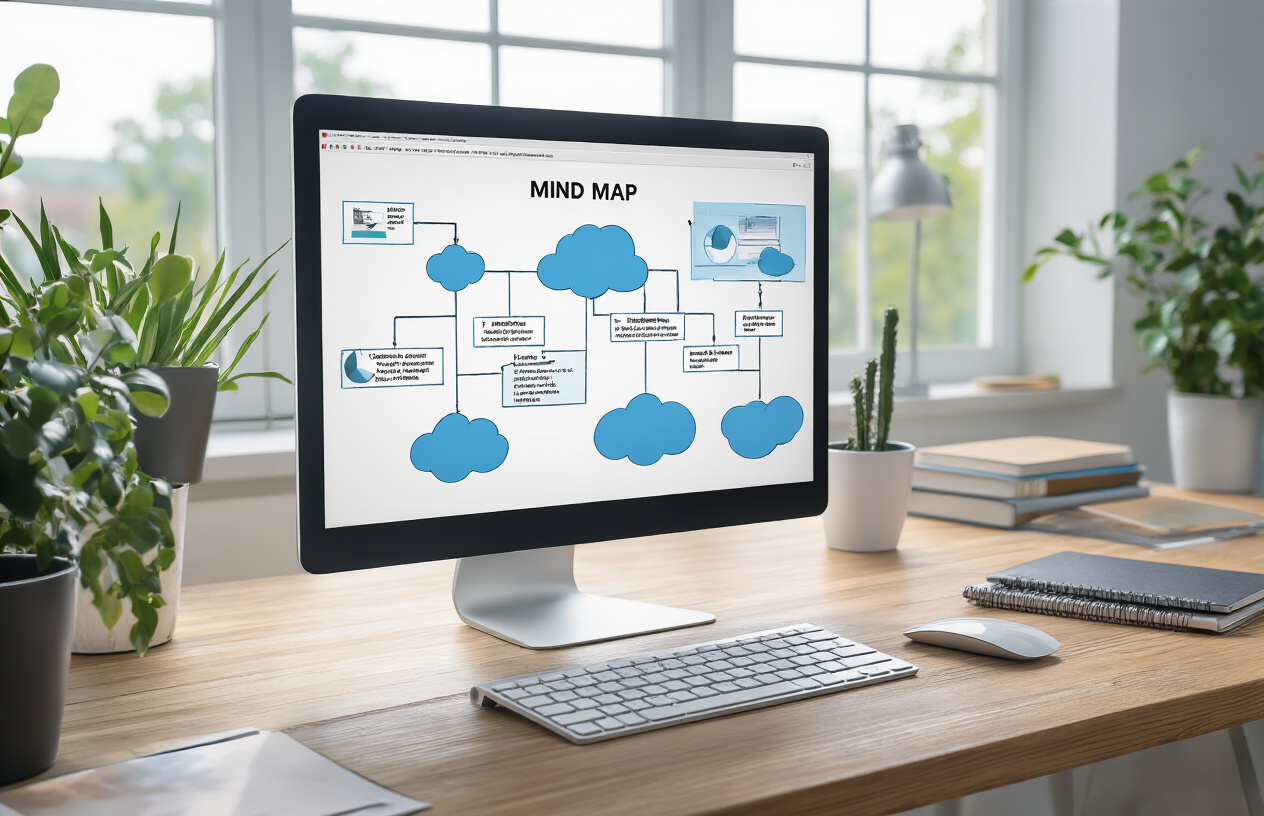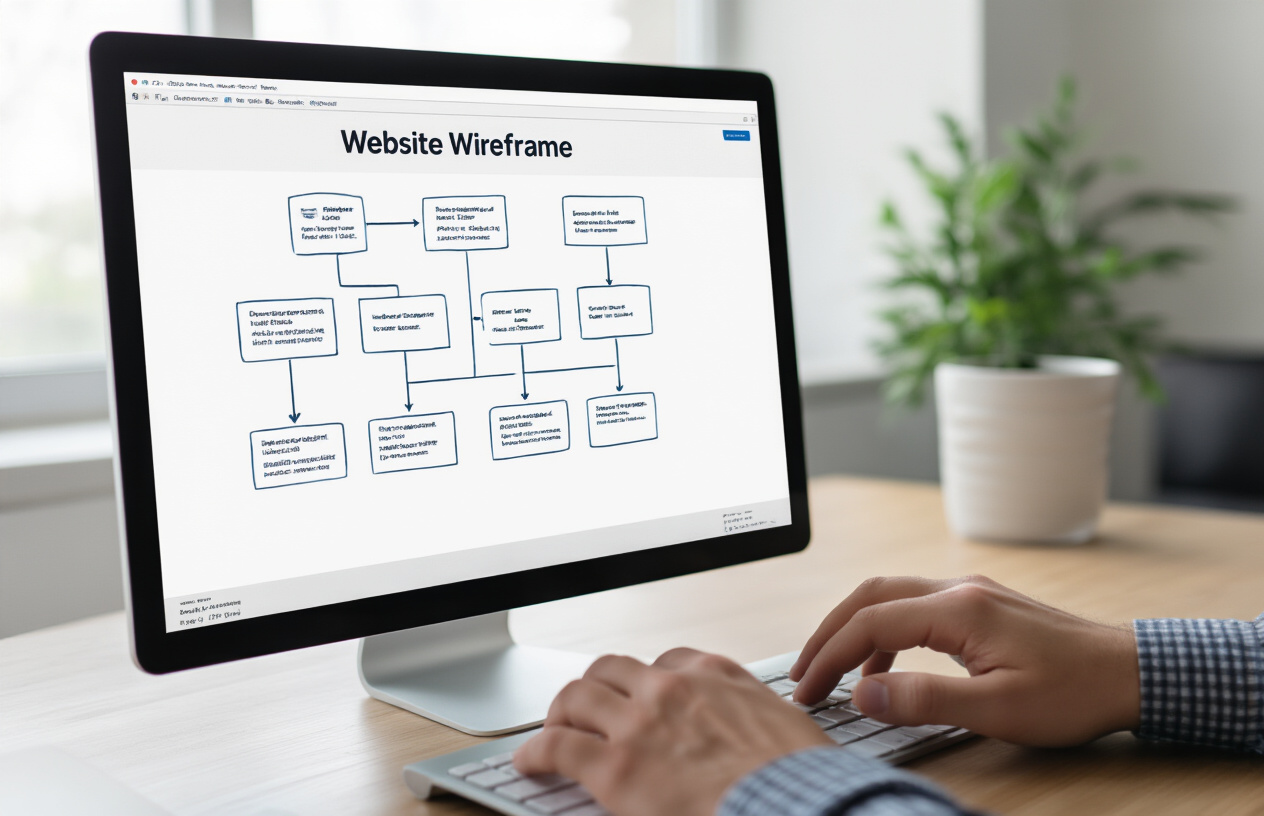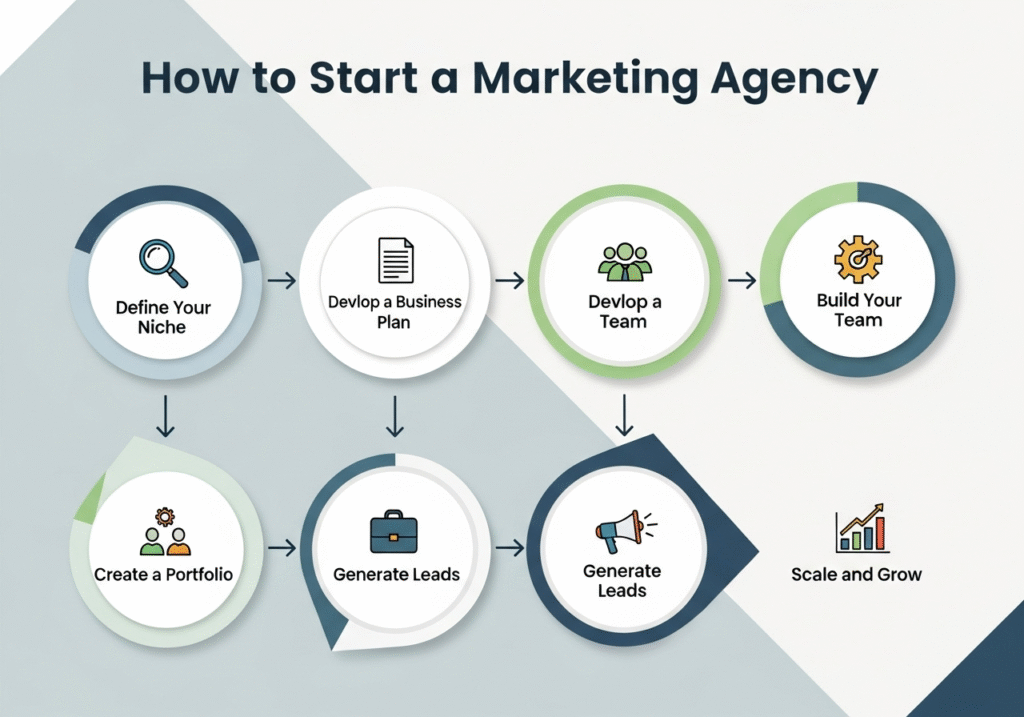Creating a topical map SEO strategy can transform your website from scattered content into a focused authority that search engines love. This comprehensive guide is designed for content marketers, SEO professionals, and website owners who want to build topical authority and climb search rankings through strategic content organization.
Many websites struggle with rankings because their content lacks connection and depth around specific subjects. A well-executed SEO topical map guide changes this by clustering related content into topic hubs that demonstrate expertise across entire subject areas.
We’ll walk through the essential steps of keyword clustering SEO and show you how to build topical authority that Google recognizes. You’ll learn how to research and map your core topics, create a logical content structure that connects related pages, and implement internal linking strategies that boost your entire topic cluster’s performance.
Learning Topical Maps and Their SEO Impact

Define Topical Maps and How They Organize Content Around Themes?
Topical maps are comprehensive content frameworks that organize your website’s information around central themes rather than individual keywords. Think of them as blueprints that connect related topics through a web of interconnected content pieces, creating what’s known as topic clusters.
A topical map seo strategy works by establishing a main pillar page that covers a broad topic comprehensively, then supporting it with cluster pages that dive deeper into specific subtopics.
For example, if your main topic is “digital marketing,” your pillar page would provide an overview, while cluster pages might focus on “email marketing,” “social media advertising,” or “content marketing strategies.”
This approach transforms your content from scattered individual posts into a cohesive knowledge hub. Each piece of content serves a specific purpose within the larger topical structure, creating clear pathways for both users and search engines to navigate related information.
The beauty of seo topical map planning lies in its holistic approach. Instead of targeting random keywords, you’re building comprehensive coverage around themes that matter to your audience. This creates natural opportunities for internal linking and establishes your site as a go-to resource for specific topics.
Discover Why Search Engines Favor Topically Relevant Websites
Search engines have evolved far beyond simple keyword matching. Google’s algorithms now prioritize websites that demonstrate expertise and comprehensive coverage of topics, a concept known as topical authority seo.
When you implement a topical seo strategy, you’re essentially proving to search engines that your website is a reliable source of information on specific subjects. This happens because:
- Content depth signals expertise: Covering multiple aspects of a topic shows you understand it thoroughly
- User engagement improves: Visitors spend more time on sites that answer related questions in one place
- Natural linking patterns emerge: Quality topical content naturally attracts backlinks from other authoritative sources
- Search intent matching increases: Comprehensive topic coverage helps match various user search intents
Search engines reward this approach because it aligns with their primary goal: providing users with the most relevant and helpful information. When your topical map for seo covers a subject comprehensively, you’re more likely to satisfy user queries completely, leading to better rankings across multiple related search terms.
Learn The Difference Between Keyword Targeting and Topical Authority
Traditional keyword clustering seo focuses on ranking for specific search terms, while topical authority takes a broader, more strategic approach to content creation.
| Keyword Targeting | Topical Authority |
|---|---|
| Focuses on individual keywords | Covers entire topic themes |
| Creates isolated content pieces | Builds interconnected content clusters |
| Targets specific search volumes | Captures semantic search variations |
| Limited long-term growth | Scalable authority building |
| Reactive to keyword research | Proactive topic coverage |
The old-school approach meant creating separate pages for “best running shoes,” “cheap running shoes,” and “running shoes for beginners.” A topical map content strategy would instead create a comprehensive running shoes resource that naturally covers all these variations while establishing your site as the definitive source for running shoe information.
Build topical authority by shifting from asking “What keywords should I target?” to “What topics does my audience need help with?” This mindset change leads to more natural content creation that serves users better while positioning your site as an expert resource.
Topical authority also captures the long tail of search queries that traditional keyword research might miss. When you cover a topic thoroughly, you naturally rank for hundreds of related phrases that people actually use when searching, creating a more sustainable and comprehensive SEO strategy.
Research and Identify Your Core Topics

Analyze Competitor Content Clusters For Topic Opportunities
Start by examining your top competitors’ content structures to uncover gaps and opportunities in your topical map SEO strategy. Look for the main topic clusters they’ve built around and identify subtopics they might have missed.
Tools like Ahrefs’ Site Explorer or SEMrush’s Topic Research feature help you see which content pieces drive the most organic traffic for competitors.
Pay attention to their pillar pages and supporting cluster content. Notice how they organize related topics and which keywords they target within each cluster. This competitive analysis reveals proven topics that work in your industry while highlighting areas where you can create better, more comprehensive content.
Create a spreadsheet listing competitor domains, their main topic clusters, and the specific subtopics they cover. This gives you a clear picture of the content landscape and helps you spot opportunities they’ve overlooked.
Use Keyword Research Tools to Find Related Subtopics
Traditional keyword research tools like Google Keyword Planner, Ahrefs Keywords Explorer, and SEMrush provide the foundation for building your topical authority. Start with your main topic and use these tools to discover related terms, long-tail variations, and semantically connected keywords.
Google’s “People Also Ask” sections and related searches at the bottom of search results reveal natural subtopic clusters. Tools like Answer the Public generate questions around your core topics, showing exactly what your audience wants to know.
Export keyword lists and group them by theme and search intent. Look for patterns in the data that suggest natural topic clusters. For example, if you’re in the fitness space, keywords around “weight loss” might cluster with “meal planning,” “calorie counting,” and “workout routines.”
Validate Topic Relevance with Search Volume Data
Search volume data helps prioritize which topics deserve dedicated content within your topical map content strategy. Focus on topics with sufficient monthly search volume to justify the content creation effort, but don’t ignore low-volume, high-intent keywords that could drive qualified traffic.
Use the following criteria to evaluate topic viability:
- High-volume topics: 1,000+ monthly searches for pillar content
- Medium-volume topics: 100-1,000 monthly searches for cluster content
- Low-volume, high-intent topics: 10-100 monthly searches for specific supporting content
| Topic Priority | Monthly Search Volume | Content Type | Purpose |
|---|---|---|---|
| High | 1,000+ | Pillar Pages | Main topic authority |
| Medium | 100-1,000 | Cluster Content | Supporting topics |
| Low/High-Intent | 10-100 | Targeted Articles | Specific queries |
Balance search volume with competition levels. Sometimes targeting medium-volume keywords with lower competition scores better than chasing high-volume terms dominated by established authorities.
Map Topics to Your Target Audience’s Search Intent
Understanding search intent transforms your keyword list into a strategic topical SEO strategy. Categorize each topic cluster by the four main types of search intent:
Informational Intent: Users seeking knowledge or answers. These topics work well for educational content that builds topical authority. Examples include “how to complete a topical map SEO” or “what is keyword clustering SEO.”
Commercial Intent: Users comparing options before making decisions. Create comparison guides, reviews, and “best of” content for these topics.
Transactional Intent: Users ready to take action or make purchases. These topics need clear calls-to-action and conversion-focused content.
Navigational Intent: Users looking for specific brands or websites. These topics help with brand awareness and direct traffic.
Match your content format to search intent. Informational queries need comprehensive guides and tutorials, while transactional searches require product pages or service descriptions. This alignment ensures your topical map serves both search engines and user needs effectively.
Create user personas for each topic cluster, considering where your audience sits in the buyer’s journey. Early-stage users need educational content, while later-stage users want specific solutions and comparisons. This mapping ensures your SEO topical map guide addresses real user needs rather than just search volume numbers.
Create Your Topical Map Structure

Establish Pillar Pages as Your Main Topic Hubs
Pillar pages serve as the backbone of your topical map SEO strategy. These comprehensive, authoritative pages cover broad topics relevant to your business and act as the central hub for related content.
Think of them as the main chapters in your website’s story – each pillar page should target high-volume, competitive keywords while providing substantial value to readers. When creating pillar pages, aim for content that spans 3,000-5,000 words and covers every angle of your chosen topic.
For example, if you’re in the fitness industry, a pillar page might focus on “Strength Training” and cover everything from beginner basics to advanced techniques, equipment recommendations, and safety considerations.
Your pillar pages should address the searcher’s intent comprehensively, answering questions they didn’t even know they had. This approach helps build topical authority by demonstrating your expertise across the entire subject matter rather than just touching on surface-level information.
Plan Supporting Cluster Content Around Each Pillar
Supporting cluster content forms the ecosystem around each pillar page, diving deeper into specific subtopics. These pieces typically range from 800-2,000 words and target long-tail keywords related to your main pillar topic.
Using our strength training example, cluster content might include:
- “Best Deadlift Variations for Beginners”
- “How to Progressive Overload Safely”
- “Pre-Workout Nutrition for Strength Athletes”
- “Common Squat Mistakes and How to Fix Them”
Each cluster piece should link back to its parent pillar page while also connecting to other relevant cluster content. This creates a web of interconnected content that search engines can easily crawl and understand. Your topical seo strategy becomes stronger when cluster content supports and amplifies the authority of your pillar pages.
Plan 5-15 cluster pieces per pillar page, depending on the breadth of your topic and available keyword opportunities. Research related keywords, common questions, and gaps in competitor content to identify cluster opportunities.
Design Internal Linking Pathways Between Related Topics
Smart internal linking transforms individual pieces of content into a cohesive seo content topical map. Your linking strategy should create logical pathways that guide both users and search engines through related topics naturally.
Start by linking every cluster page to its parent pillar page using relevant anchor text. Then, create contextual links between cluster pages that share related subtopics. For instance, a cluster page about “Protein Requirements for Muscle Building” should link to other nutrition-related cluster content within the same topic group.
Create a linking hierarchy that flows like this:
- Homepage → Pillar Pages
- Pillar Pages → Cluster Content
- Cluster Content → Related Cluster Content
- All Content → Relevant Pillar Pages
Avoid over-linking or forcing unnatural connections. Each internal link should provide genuine value to the reader’s journey. Use descriptive anchor text that includes relevant keywords without keyword stuffing.
Prioritize Topics Based on Business Goals and Search Difficulty
Not all topics deserve equal attention in your topical map content strategy. Prioritization ensures you invest resources where they’ll have the greatest impact on your business objectives and SEO performance.
Evaluate potential topics using this framework:
| Priority Factor | High Priority | Medium Priority | Low Priority |
|---|---|---|---|
| Business Relevance | Directly drives conversions | Supports brand awareness | Educational only |
| Search Volume | 10,000+ monthly searches | 1,000-10,000 searches | Under 1,000 searches |
| Competition Level | Achievable with effort | Moderate competition | Highly competitive |
| Content Gaps | Major opportunity | Some opportunity | Saturated market |
Start with topics that align closely with your revenue-generating activities and have reasonable competition levels. If you’re just beginning to build topical authority, choose topics where you can realistically compete rather than going head-to-head with industry giants.
Consider seasonal trends, emerging opportunities, and your existing content strengths when making prioritization decisions. A well-executed topical map in a smaller niche often outperforms a scattered approach across multiple highly competitive topics.
Develop Content for Each Topic Cluster

Write Comprehensive Pillar Pages Covering Broad Topics
Pillar pages serve as the foundation of your topical map SEO strategy. These comprehensive resources need to cover your main topics with enough depth to establish topical authority while remaining accessible to your target audience. Each pillar page should address the core question or problem that defines your topic cluster.
Start by creating content that spans 3,000-5,000 words for each pillar page. This length allows you to cover all essential aspects of your broad topic without overwhelming readers. Your pillar page should include multiple subtopics that you’ll later expand into cluster content, creating natural opportunities for internal linking.
Structure your pillar pages with clear sections that address different angles of your main topic. Include actionable insights, expert tips, and real-world examples that demonstrate your expertise. Search engines reward content that thoroughly covers a subject, so don’t shy away from going deep into technical details when appropriate.
Remember to optimize your pillar pages for your primary keywords while maintaining natural language flow. These pages often rank for competitive head terms, so they need to be exceptional in both content quality and technical optimization.
Create Detailed Cluster Content Addressing Specific Subtopics
Cluster content expands on the subtopics mentioned in your pillar pages. Each piece should dive deep into one specific aspect of your broader topic, creating a web of interconnected content that strengthens your topical authority SEO efforts.
Target long-tail keywords and specific user queries with your cluster content. While pillar pages cast a wide net, cluster pages should answer very specific questions that your audience asks. This approach helps you capture more granular search traffic and builds comprehensive topic coverage.
Plan for 1,500-2,500 words per cluster page, depending on the complexity of the subtopic. Some technical subjects may require longer content, while straightforward how-to topics might work well with shorter, more focused pieces.
Create content variations that address the same subtopic from different angles. For example, if your pillar page covers “digital marketing,” your cluster content might include “digital marketing for small businesses,” “digital marketing tools,” and “digital marketing metrics.” This strategy helps you build topical authority while avoiding content cannibalization.
Ensure Content Depth Matches User Search Intent
Understanding search intent becomes crucial when developing your topical map content strategy. Different types of queries require different content approaches, and matching this intent directly impacts your SEO success.
Informational intent requires comprehensive, educational content that answers questions thoroughly. Users searching for “what is SEO” want detailed explanations, examples, and context. Your content should provide complete answers that satisfy their curiosity without requiring additional searches.
Transactional intent demands content that guides users toward making decisions. Product comparisons, reviews, and buying guides work well here. Include clear calls-to-action and practical advice that helps users move forward in their journey.
Navigational intent often indicates users looking for specific resources or tools. Create content that serves as a hub for related resources, making it easy for users to find exactly what they need within your topic cluster.
Commercial investigation intent sits between informational and transactional. Users are researching solutions but aren’t ready to buy yet. Provide balanced, helpful information that builds trust while subtly demonstrating your expertise.
Optimize Content Length and Format For Each Topic Level
Different topic levels require different content approaches to maximize both user experience and SEO performance. Your topical map SEO strategy should account for these variations in format and length.
| Content Type | Recommended Length | Primary Format | Key Features |
|---|---|---|---|
| Pillar Pages | 3,000-5,000 words | Long-form guides | Multiple sections, comprehensive coverage |
| Cluster Content | 1,500-2,500 words | Focused articles | Specific subtopics, detailed exploration |
| Supporting Content | 800-1,500 words | Targeted pieces | Quick answers, specific queries |
Match your content format to user preferences and search patterns. Visual topics benefit from infographics, charts, and images. Technical subjects might need step-by-step tutorials with screenshots. Complex topics work well with video content embedded alongside written explanations.
Consider mobile users when planning content length and format. Break up long sections with subheadings, bullet points, and visual elements. Most users scan content rather than reading every word, so make your key points easy to find and digest.
Test different content formats within your topic clusters to see what resonates best with your audience. Some topics perform better as comprehensive guides, while others work well as quick reference materials. Your analytics will reveal which approach generates the best engagement and SEO results for each topic level.
Implement Strategic Internal Linking

Link Cluster Pages To Relevant Pillar Pages Consistently
Every cluster page you create needs a strong connection back to its parent pillar page. This connection forms the backbone of your topical map seo structure and helps search engines understand the relationship between your content pieces. Set up a system where each cluster page links to its main pillar page at least once in the body content, preferably within the first few paragraphs.
The key here is consistency across your entire seo content topical map. When you have multiple cluster pages supporting a single pillar, they should all follow the same linking pattern. This creates a web of connections that reinforces your topical authority seo signals to search engines.
Consider creating a standardized template or checklist for your content creators. This ensures every new cluster page automatically includes the required pillar page links without anyone having to remember or guess. Your topical seo strategy depends on these foundational connections being in place from day one.
Create Contextual Links Between Related Cluster Content
Smart internal linking goes beyond just connecting clusters to pillars. The real magic happens when you link related cluster pages to each other. This cross-linking creates a stronger topical network and keeps visitors engaged longer on your site.
Look for natural opportunities to reference related topics within your cluster content. When writing about advanced SEO techniques, you might naturally mention content optimization strategies covered in another cluster page. These contextual connections help build topical authority by showing search engines the depth of your expertise across related subjects.
Create a content mapping document that tracks which cluster pages relate to others. This reference makes it easier for writers to identify linking opportunities while creating new content. Your topical map content strategy becomes more powerful when every piece of content supports and references other relevant pieces in your ecosystem.
Don’t force these connections, though. The links should feel natural and provide genuine value to readers seeking additional information on related topics.
Use Descriptive Anchor Text That Reinforces Topical Relevance
Your anchor text choices can make or break your internal linking strategy. Generic phrases like “click here” or “read more” waste valuable SEO opportunities. Instead, use descriptive anchor text that clearly indicates what the linked page covers and reinforces your keyword clustering seo efforts.
When linking from a cluster page about keyword research to your pillar page about SEO strategy, use anchor text like “comprehensive SEO strategy guide” rather than “this article.” This approach helps search engines understand the topical relationship between pages while providing clear expectations for users.
Vary your anchor text to avoid over-optimization penalties. If your pillar page targets “topical map for seo,” don’t use that exact phrase every time you link to it. Mix in variations like “SEO topical mapping guide,” “topical SEO approach,” or “content cluster strategy.”
Keep track of your anchor text usage across your site. Spreadsheets or SEO tools can help monitor which phrases you’re using most frequently and ensure you maintain a natural distribution that supports your overall topical map seo objectives.
Monitor and Optimize Your Topical Map Performance

Track Keyword Rankings Across All Topic Clusters
Building a comprehensive ranking tracking system is essential for measuring your topical map’s success. Set up monitoring for both pillar page keywords and long-tail cluster keywords to get the full picture of your topical authority performance. Use tools like SEMrush, Ahrefs, or Google Search Console to create custom tracking groups for each topic cluster.
Create weekly reports that show ranking movements across your entire topical map structure. Pay special attention to how your pillar pages rank for competitive head terms, while monitoring cluster pages for their target long-tail keywords. This dual approach helps you understand whether your topical authority SEO strategy is working at both the broad topic level and the specific subtopic level.
Set up automated alerts for significant ranking changes, especially drops of 5+ positions for important keywords. Quick response to ranking fluctuations can prevent minor issues from becoming major problems.
Analyze Organic Traffic Growth for Pillar and Cluster Pages
Dive deep into your Google Analytics data to track organic traffic patterns across your topical map structure. Create custom segments that separate pillar page traffic from cluster page traffic, allowing you to see which part of your topical seo strategy drives the most valuable visitors.
Look for traffic distribution patterns that indicate healthy topic cluster performance. Ideally, you’ll see steady growth in both pillar and cluster page traffic, with cluster pages feeding qualified traffic to your pillar content through internal links.
Monitor key metrics beyond just page views:
- Average session duration on cluster vs. pillar pages
- Pages per session to measure topic exploration depth
- Conversion rates from different cluster topics
- Bounce rates across topic clusters
Pay attention to seasonal trends and content lifecycle patterns. Some cluster topics might perform better during specific times of year, helping you plan content updates and promotional campaigns.
Identify Content Gaps and Expansion Opportunities
Regular gap analysis keeps your seo content topical map competitive and comprehensive. Use keyword research tools to discover new subtopics and related questions that your competitors are ranking for but you haven’t covered yet.
Analyze your existing cluster pages’ search console data to find keywords you’re ranking for on pages 2-3 of search results. These represent quick win opportunities where additional content or page optimization could push you onto page 1.
Create a systematic approach to gap identification:
| Gap Type | Identification Method | Action Required |
|---|---|---|
| Missing Subtopics | Competitor content analysis | Create new cluster pages |
| Thin Content Areas | Low word count pages with poor rankings | Expand existing content |
| User Intent Gaps | Search console impression data | Add new content angles |
| Seasonal Opportunities | Google Trends analysis | Plan seasonal cluster content |
Monitor user-generated content like comments, social media discussions, and customer support tickets for emerging subtopics within your main themes. These real user questions often reveal content opportunities that keyword tools miss.
Refine Internal Linking Based on User Behavior Data
Your internal linking strategy should evolve based on how users actually navigate your topical map. Use Google Analytics’ Behavior Flow reports to see the most common paths users take through your cluster content.
Heat mapping tools like Hotjar or Crazy Egg reveal which internal links users click most frequently on your pillar and cluster pages. This data helps you optimize link placement and anchor text to guide users more effectively through your topic clusters.
Test different internal linking approaches using your build topical authority framework:
- Contextual links within content body vs. sidebar recommendations
- Related posts sections vs. inline topic cluster navigation
- Breadcrumb systems that emphasize topical relationships
Track click-through rates on internal links and adjust based on performance. Links with low click rates might need better anchor text or more prominent placement, while high-performing links can be replicated across similar cluster pages.
Review your internal linking structure quarterly to ensure it still supports your topical map content strategy goals. As you add new cluster content, update older pages to include links to fresh material, maintaining the interconnected web that search engines love.

Topical maps transform scattered content into a powerful SEO strategy that search engines love. By organizing your website around core topics and creating comprehensive content clusters, you build topical authority that helps your pages rank higher and attract more organic traffic.
The key lies in thorough research, strategic structure, and consistent internal linking that guides both users and search engines through your expertise. Start mapping your topics today and watch your search rankings improve over time.
Focus on creating valuable, interconnected content that answers your audience’s questions while demonstrating your knowledge across related subjects. Remember to track your performance regularly and adjust your strategy based on what’s working best for your specific niche and audience needs.



